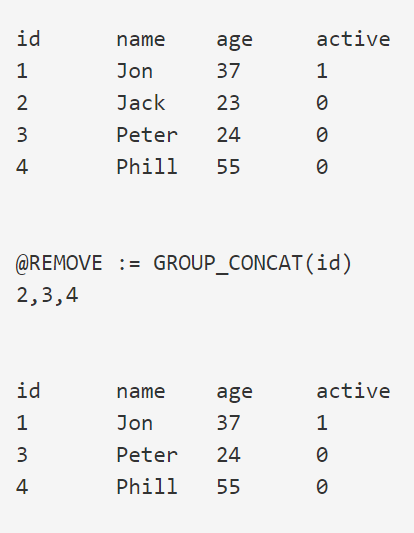Is there is a way to delete records using WHERE IN @VARIABLE?
-- DEMO TABLE
CREATE TABLE people (
id int AUTO_INCREMENT NOT NULL,
name varchar(100),
age int,
active smallint DEFAULT 0,
PRIMARY KEY (id)
);
-- DEMO DATA
INSERT INTO people(id, name, age, active)
VALUES
(1, 'Jon', 37, 1),
(2, 'Jack', 23, 0),
(3, 'Peter', 24, 0),
(4, 'Phil', 55, 0);
Create variable:
SELECT @REMOVE := GROUP_CONCAT(id) FROM people WHERE active < 1; -- (2,3,4)
I'm trying to remove concatenated variables from string.
DELETE FROM people WHERE id IN(@REMOVE); -- will delete only first id which is id nr 2
The above SQL removes only first element from the list. In this example, list will contain: (2,3,4). Only the record with id = 2 will be removed. Records with id 3, 4 will remain in the table. See the table before and after in the image below:
I am well aware that I could use on of two solutions like:
Subquery:
-- SOLUTION 1 - USEING NESTED SELECT SUB QUERY WITH AN ALIAS
DELETE FROM people WHERE id IN(SELECT * FROM (SELECT id FROM people WHERE active < 1) as temp);
Solution 1 is not ideal if we need to run same subquery in different query at a later point, wanting to preserve the original output while running insert, update or delete operations on the same table.
or
Temp table:
CREATE TEMPORARY TABLE temp_remove_people (id int NOT NULL PRIMARY KEY);
INSERT INTO temp_remove_people SELECT id FROM people WHERE active < 1;
DELETE FROM people WHERE id IN(SELECT id FROM temp_remove_people);
This will preseve original select within same session.
I would like to know if it is possible to use concatenated variable in some different way to make it work.


group_concat? Also, you use do not the outerSELECT * FROM. Can you show problem with data or SQL? – Autoerotism